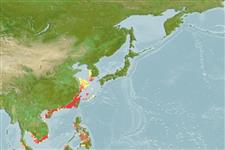>
Clupeiformes (Herrings) >
Dorosomatidae (Gizzard shads and sardinellas)
Etymology: Clupanodon: Latin, clupea = sardine, derived from Clupeus = shield; doubtless a reference to the scales covering the body of the fish (Ref. 45335).
More on author: Linnaeus.
Environment: milieu / climate zone / depth range / distribution range
Écologie
marin; eau douce; saumâtre; anadrome (Ref. 51243); profondeur 0 - 50 m (Ref. 188). Tropical; 41°N - 6°N, 98°E - 128°E (Ref. 188)
Northwest Pacific: China, apparently south to Viet Nam (Philippine records of Fowler appear doubtful). Eastern Indian Ocean: Specimens were recorded from Phuket Island, Thailand (Andaman Sea).
Taille / Poids / Âge
Maturity: Lm ? range ? - ? cm
Max length : 26.0 cm SL mâle / non sexé; (Ref. 188)
Épines dorsales (Total): 0; Épines anales 0; Rayons mous anaux: 22 - 28. Body moderately deep; belly with 16 to 19 (usually 18) + 9 to 12 (usually 10 or 11) total 27 to 31 (usually 29 or 30) scutes; pre-dorsal scutes present, 17 to 26 (usually 20 to 25). gill rakers of first arch at least 3/4 length of gill filaments. Vertebrae 43 to 46 (usually 44 or 45). A dark spot behind gill opening, followed by further spots on flank.
Found in coastal waters and in rivers, presumably tolerating brackish water, if not fully fresh condition. More data needed.
Life cycle and mating behavior
Maturité | Reproduction | Frai | Œufs | Fécondité | Larves
Whitehead, P.J.P., 1985. FAO Species Catalogue. Vol. 7. Clupeoid fishes of the world (suborder Clupeoidei). An annotated and illustrated catalogue of the herrings, sardines, pilchards, sprats, shads, anchovies and wolf-herrings. FAO Fish. Synop. 125(7/1):1-303. Rome: FAO. (Ref. 188)
Statut dans la liste rouge de l'IUCN (Ref. 130435)
Menace pour l'homme
Reports of ciguatera poisoning (Ref. 4690)
Utilisations par l'homme
Pêcheries: commercial
Plus d'informations
Noms communsSynonymesMétabolismePrédateursÉcotoxicologieReproductionMaturitéFraiRassemblement de ponteFéconditéŒufsDéveloppement de l'œuf
RéférencesAquacultureProfil d'aquacultureSouchesGénétiqueElectrophoresesHéritabilitéPathologiesTraitementNutrientsMass conversion
CollaborateursImagesStamps, Coins Misc.SonsCiguateraVitesseType de nageSurface branchialeOtolithesCerveauxVision
Outils
Articles particuliers
Télécharger en XML
Sources Internet
Estimates based on models
Preferred temperature (Ref.
123201): 24 - 29, mean 27.4 °C (based on 184 cells).
Phylogenetic diversity index (Ref.
82804): PD
50 = 1.0000 [Uniqueness, from 0.5 = low to 2.0 = high].
Bayesian length-weight: a=0.00933 (0.00531 - 0.01641), b=3.07 (2.92 - 3.22), in cm total length, based on LWR estimates for this species & (Sub)family-body (Ref.
93245).
Niveau trophique (Ref.
69278): 3.1 ±0.3 se; based on size and trophs of closest relatives
Generation time: 3.1 ( na - na) years. Estimated as median ln(3)/K based on 2
growth studies.
Résilience (Ref.
120179): Haut, temps minimum de doublement de population inférieur à 15 mois (Assuming tm=1).
Prior r = 1.19, 95% CL = 0.79 - 1.79, Based on 1 stock assessment.
Fishing Vulnerability (Ref.
59153): Low to moderate vulnerability (27 of 100).
Climate Vulnerability (Ref.
125649): Very high vulnerability (78 of 100).
Nutrients (Ref.
124155): Calcium = 190 [104, 334] mg/100g; Iron = 1.8 [1.1, 2.9] mg/100g; Protein = 19 [18, 20] %; Omega3 = 0.415 [0.238, 0.736] g/100g; Selenium = 38 [19, 72] μg/100g; VitaminA = 34.9 [15.0, 81.3] μg/100g; Zinc = 1.58 [1.12, 2.27] mg/100g (wet weight);
